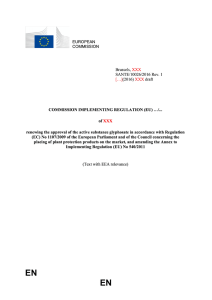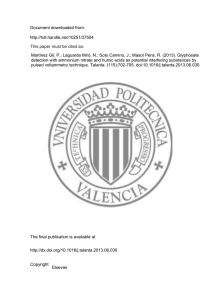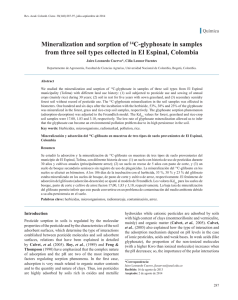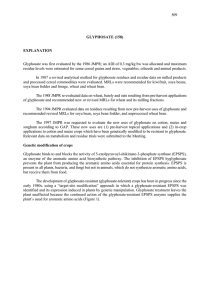Dissipation of glyphosate from grapevine soils in Sonora, Mexico
Anuncio
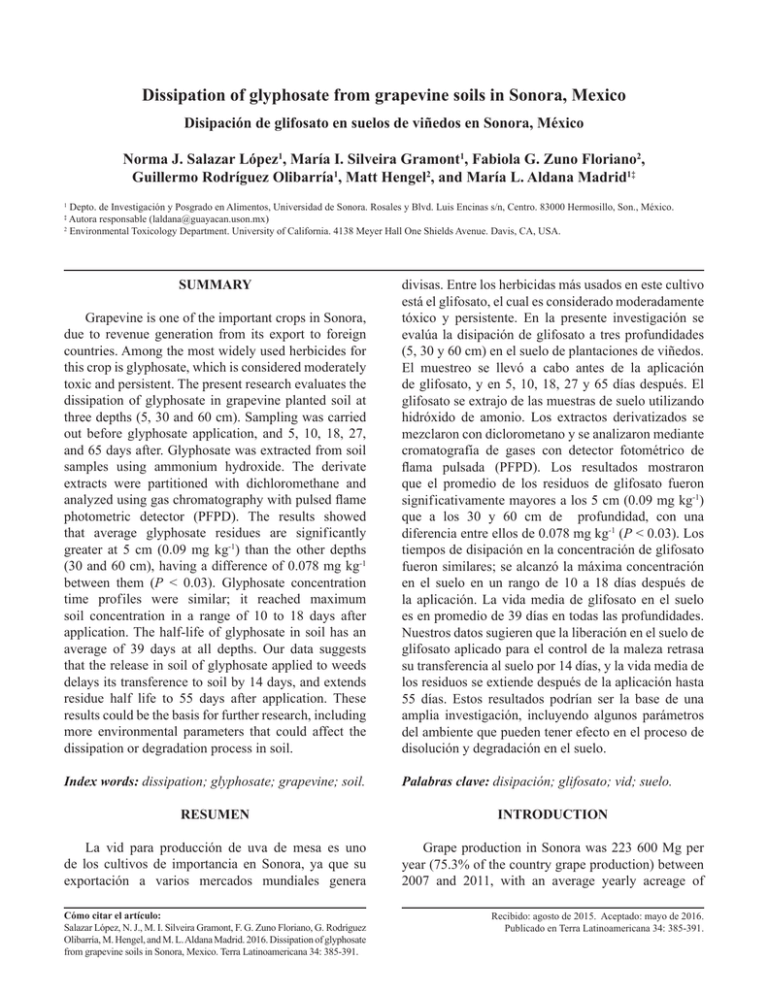
Dissipation of glyphosate from grapevine soils in Sonora, Mexico Disipación de glifosato en suelos de viñedos en Sonora, México Norma J. Salazar López1, María I. Silveira Gramont1, Fabiola G. Zuno Floriano2, Guillermo Rodríguez Olibarría1, Matt Hengel2, and María L. Aldana Madrid1‡ Depto. de Investigación y Posgrado en Alimentos, Universidad de Sonora. Rosales y Blvd. Luis Encinas s/n, Centro. 83000 Hermosillo, Son., México. Autora responsable (laldana@guayacan.uson.mx) 2 Environmental Toxicology Department. University of California. 4138 Meyer Hall One Shields Avenue. Davis, CA, USA. 1 ‡ SUMMARY Grapevine is one of the important crops in Sonora, due to revenue generation from its export to foreign countries. Among the most widely used herbicides for this crop is glyphosate, which is considered moderately toxic and persistent. The present research evaluates the dissipation of glyphosate in grapevine planted soil at three depths (5, 30 and 60 cm). Sampling was carried out before glyphosate application, and 5, 10, 18, 27, and 65 days after. Glyphosate was extracted from soil samples using ammonium hydroxide. The derivate extracts were partitioned with dichloromethane and analyzed using gas chromatography with pulsed flame photometric detector (PFPD). The results showed that average glyphosate residues are signif icantly greater at 5 cm (0.09 mg kg-1) than the other depths (30 and 60 cm), having a difference of 0.078 mg kg-1 between them (P < 0.03). Glyphosate concentration time prof iles were similar; it reached maximum soil concentration in a range of 10 to 18 days after application. The half-life of glyphosate in soil has an average of 39 days at all depths. Our data suggests that the release in soil of glyphosate applied to weeds delays its transference to soil by 14 days, and extends residue half life to 55 days after application. These results could be the basis for further research, including more environmental parameters that could affect the dissipation or degradation process in soil. divisas. Entre los herbicidas más usados en este cultivo está el glifosato, el cual es considerado moderadamente tóxico y persistente. En la presente investigación se evalúa la disipación de glifosato a tres profundidades (5, 30 y 60 cm) en el suelo de plantaciones de viñedos. El muestreo se llevó a cabo antes de la aplicación de glifosato, y en 5, 10, 18, 27 y 65 días después. El glifosato se extrajo de las muestras de suelo utilizando hidróxido de amonio. Los extractos derivatizados se mezclaron con diclorometano y se analizaron mediante cromatografía de gases con detector fotométrico de flama pulsada (PFPD). Los resultados mostraron que el promedio de los residuos de glifosato fueron signif icativamente mayores a los 5 cm (0.09 mg kg‑1) que a los 30 y 60 cm de profundidad, con una diferencia entre ellos de 0.078 mg kg-1 (P < 0.03). Los tiempos de disipación en la concentración de glifosato fueron similares; se alcanzó la máxima concentración en el suelo en un rango de 10 a 18 días después de la aplicación. La vida media de glifosato en el suelo es en promedio de 39 días en todas las profundidades. Nuestros datos sugieren que la liberación en el suelo de glifosato aplicado para el control de la maleza retrasa su transferencia al suelo por 14 días, y la vida media de los residuos se extiende después de la aplicación hasta 55 días. Estos resultados podrían ser la base de una amplia investigación, incluyendo algunos parámetros del ambiente que pueden tener efecto en el proceso de disolución y degradación en el suelo. Index words: dissipation; glyphosate; grapevine; soil. Palabras clave: disipación; glifosato; vid; suelo. RESUMEN INTRODUCTION La vid para producción de uva de mesa es uno de los cultivos de importancia en Sonora, ya que su exportación a varios mercados mundiales genera Grape production in Sonora was 223 600 Mg per year (75.3% of the country grape production) between 2007 and 2011, with an average yearly acreage of Cómo citar el artículo: Salazar López, N. J., M. I. Silveira Gramont, F. G. Zuno Floriano, G. Rodríguez Olibarría, M. Hengel, and M. L. Aldana Madrid. 2016. Dissipation of glyphosate from grapevine soils in Sonora, Mexico. Terra Latinoamericana 34: 385-391. Recibido: agosto de 2015. Aceptado: mayo de 2016. Publicado en Terra Latinoamericana 34: 385-391. 386 TERRA LATINOAMERICANA VOLUMEN 34 NÚMERO 4, 2016 19 105 ha, yielding 11.66 Mg ha-1 (INEGI, 2012). Within the state, Hermosillo Valley had an acreage of 10912 ha, and Caborca 7903 ha. In 2010 Mexico exported 171 325 tons of table grapes, ranking seventh in the list of world exporters (FAOSTAT, 2010; INEGI, 2012). Grape (Vitis vinífera L.) is a perennial crop that could last up to 20 years in good standing. In Hermosillo Valley the most common cultivars are Perlette, Flame, Superior (Sugraone) and Red Globe (INIFAP, 2010). Vineyards are planted mostly in yermosol soil. This soil type is salt-free, sandy, with medium texture, low organic matter, and a depth that ranges between 20 and 100 cm (INEGI, 2012). Most vineyards utilize a “Y” trellis system with drip irrigation systems positioned 50 cm above the soil surface (INIFAP, 2010). Irrigation water comes from two aquifers (superior and inferior) proceeding from the Bacoachi and Sonora river basins (Quevedo1, 2007). Among other factors, grape production is susceptible to weeds; thus, cultivation practices include herbicide applications to control weeds and reduce their negative effects on plant development and grape quality. Glyphosate is one of the herbicides recommended to control knotgrass (Convolvulus arvensis L.), Johnson grass (Sorghum halepense L.), and Bermuda grass (Cynodon dactylon L.) in Sonora’s vineyards (INIFAP, 2010). Glyphosate [N-(phosphonomethyl) glycine, CAS No. 1071-83-6] is an isopropyl amine salt with a molecular weight of 228.18 g mol‑1. Classif ied as an organophosphorus broad-spectrum herbicide, glyphosate has non-selective and systemic foliar action (Prata et al., 2003; Gimsing et al., 2007; Sanchís et al., 2012). Several studies focus on the mechanisms of glyphosate leakage, runoff, translocation, or interaction with soil particles, minerals and microorganisms. In general, they agree that glyphosate is fairly stable in the soil, and its degradation depends on the type of soil, where soil structure, pH, organic matter, microorganisms, metals and fertilization are the factors involved. Soil pH is an important factor for glyphosate sorption, correlating negatively with low pH (Helander et al., 2012). The high solubility of glyphosate in water (12 000 mg L-1) aids its transportation by drip irrigation water from the planted soil surface to deeper soil layers. Such molecules can be transported to surface and/or ground water, either in solution or in suspension when bound to sediments (Sanchís et al., 2012). Leaching and subsurface runoff are important processes with respect to contamination risk in the aquatic environment (ground or drainage water) (Kjaer et al., 2005, 2011; Borggaard and Gimsing 2008). Torstensson et al. (2005), reported glyphosate residues above 0.1 µg L-1 in ground water samples. To date, there are no reported studies on the impact of glyphosate on Sonora’s vineyards soils; therefore, the aim of this research is to determine the behavior of glyphosate residues in grapevine planted soils at three different depths, before application and until grape maturity. The results of this research will aid in evaluating the potential environmental risks involved with the use of glyphosate. MATERIALS AND METHODS Experiment Description The experiment was conducted in a commercial vineyard situated in Costa de Hermosillo District of Sonora (Mexico) located at 29° 00’ 53’’ N, 111° 29’ 16’’ W (Datum WGS84) coordinates, and 78 m above sea level. The cultivar used was Red Globe, which was planted in 2006. The vineyard consisted of 106 plant rows (4 m between rows), each row with 182 plants 1.4 m apart. The vines were grown on a “Y” trellis system. As stated before, the soils are mostly yermosol with alkaline pH, low organic matter content, and a predominance of sandy loam structure. Rainfall is scarce in this region, occurring mainly in the summer. Average yearly precipitation is 200 mm. Temperatures during the growing season ranged from -3 to 46 °C (INEGI, 2012). All the crops in the district, including vineyards, are irrigated. A drip irrigation system was located at the vineyard. Drip irrigation involves dripping water onto the soil at very low rates from a system of small diameter plastic pipes f itted with outlets called emitters or drippers that are 50 cm above the soil surface. This irrigation system aims to reduce the amount of water used to reach the grapevine roots. Although the amount of water is reduced, it is incessant, and at level surfaces the sandy soil texture favors downward water f iltration (Poling, 2007). 1 Quevedo E., J. L. 2007. Propuesta de Acción para la gestión integrada en la Costa de Hermosillo, Sonora. Tesina de la especialidad en gestión integrada de cuencas hidrológicas. El Colegio de Sonora, Hermosillo, Sonora, México. http://www.ars.gob.mx/municipioshtml/HERMOSILLO/hermosillo2.htm. (Accessed: February 04, 2015). SALAZAR ET AL. DISSIPATION OF GLYPHOSATE FROM GRAPEVINE SOILS Experimental Design Five rows from the vineyard were selected randomly, and a plot of three consecutive plants within each row was selected as the experimental unit. A composite soil sample of 1 kg was extracted from 3 holes near each plant at three different soil depths (5, 30 and 60 cm). Soil samples were taken 0 (before glyphosate application), 5, 10, 18, 27 and 65 days after application (from March to June of 2011). The experimental design was completely random with three soil depths as treatments, six repeated measures in time, and f ive replicates (plots with three grapevine plants each). Soil samples were collected in polyethylene bags, transported to the lab and stored at -20 °C until soil and glyphosate residues analyses. The soil was analyzed for pH, organic matter and texture. The pH determination was carried out by the AS-02 method of NOM-021-SEMARNAT-2000, which is based on the activity of the H+ ion in a mixture of soil and water (1:2), measured by a potentiometer (Orio Star 3, Thermo Electron Co, USA). Organic matter was measured by the AS-07 method of NOM-021SEMARNAT-2000, which is based on measurement of soil organic carbon oxidation by a heated potassium dichromate solution. Texture of the soil was determined by the AS-09 method of the same Mexican Off icial Norm. Herbicide Application Glyphosate commercial grade FAENA FORTE (Bayer Crop Science, Germany) was diluted with water by f ield workers following the instructions on the label. The solution was sprayed over the weeds with a hand operated backpack sprayer. Application rate was 1.3 L ha-1 (equivalent to 702 g active ingredient per ha). During application, the temperature was 23.5 °C, wind velocity 1.7 m s-1, relative humidity 32.4%, foliar humidity was zero percent and solar radiation was 0.362 kW m2. Quantif ication of Glyphosate Residues in Soil Chemicals. The analytical standard of glyphosate (99.5%) was obtained from Chem Service Inc. (USA). Methanol (99.97%) HPLC grade was from JT Baker (USA). Hydrochloric acid (37.5%), 387 ammonium hydroxide (30%), phosphoric acid (85%) and methylene chloride (99.9%) were from Fermont (Mexico). Trifluoroacetic anhydride (TFAA) and trifluoroethanol (TFE, 99%) were from Fluka (USA). Anhydrous sodium sulfate (99%) was from Merck (USA) and ethyl acetate (99.9%) was from Burdick & Jackson (USA). Extraction, cleanup and derivatization. Samples were crushed, dried at room temperature and sieved to 2 mm maximum particle size. The extraction of glyphosate was based on a method by Hu et al. (2008). A homogenized soil sample (5 g) was extracted (2X) with 16 mL of 2 M NH4OH using a shaker for 40 min (Burrell, USA, Model 71). The samples were centrifuged for 20 min at 3500 rpm and the supernatant was poured into a 50 mL conical vessel. Subsequently, the supernatant was evaporated to dryness at 75 °C with a gentle stream of air using an N-EVAP 112 (model OA-SYS, Organomation Associates Inc., USA). The extract was re-suspended with 5 mL of water:methanol:HCl (160:40:2.7, v/v/v), 20 µL of concentrated phosphoric acid was added and the extract was kept at room temperature for 40 min. The extract was centrifuge for 20 min at 3500 rpm; the supernatant was transferred to a derivatization tube and evaporated to dryness at 80 °C with a gentle stream of air. The tube was cooled to room temperature and, after adding 1 mL of TFAA and 0.5 mL of TFE, it was kept in an icebath. The tube was then put on a hot plate (Thermolyne type 16 500 Dry-Bath, USA) at 100 °C for one hour. In this method of derivatization, the functional groups of carboxylic and phosphoric acid are derivatized to form the corresponding trifluoroethyl ester, while the amino functional group is derivatized to form the corresponding trifluoroacetyl (Hu et al., 2008). The excess reagents were removed by a gentle stream of air at 40 °C. The extract was re-suspended with 6 mL of distilled water and transferred to another vessel. This process was repeated twice; 20 mL of methylene chloride was added to a tube and shaken for 2 min, the methylene chloride layer was collected into a 50 mL tube. The aqueous layer was extracted (2X) with 20 mL of methylene chloride. The extract was dried over a bed of anhydrous sodium sulfate (2.5 g) and evaporated to dryness with air at 40 °C. The f inal extract was dissolved with 1 mL of ethyl acetate, f iltered using a 0.2 µm, 13 mm syringe f ilter unit (Pall, USA) and analyzed by gas chromatography. 388 TERRA LATINOAMERICANA VOLUMEN 34 NÚMERO 4, 2016 Gas chromatography conditions. A Varian CP 3800 gas chromatograph (Varian, USA) equipped with a capillary column DB-5 (30 m × 0.25 mm ID, 0.25 µm‑f ilm thickness, J & W Scientif ic, USA) and pulsed flame photometric detector (PFPD, phosphorus mode) was used. The chromatographic conditions used for the analysis of glyphosate residues were as follows: detector temperature 310 °C; injector temperature 220 °C; initial oven temperature was 85 °C (1 min hold), increased 20 °C min-1 to 150 °C, ramped at 20 °C min‑1 to 200 °C (2 min hold), followed by a f inal ramp of 20 °C min-1 to 250 °C (4 min hold). The total run time was 18.5 minutes, and injection volume was 2 µL. Nitrogen (N2) was used as the carrier gas, maintained at a constant flow rate of 1.1 mL min-1, which resulted in a retention time of 6.3 min for glyphosate. Data acquisition and integration was controlled by Galaxy Chromatography Data System (Varian, USA). In order to establish method linearity the following standards were used: 20, 50, 100, 200, 300, 500 and 1000 µg L-1. Concentration vs response plots were obtained and their correlation coeff icient was calculated. All injections were done in triplicate. Percentage recovery of glyphosate in soil samples. The effectiveness of the analytical process was measured with percent recovery (% Rec) using spiked control samples at three different fortif ication levels (0.02, 0.2 and 0.6 mg kg-1) with three replicates. Soil samples (5 g) were fortif ied and subsequently analyzed according to the previously described extraction method. The acceptable recovery percentage was stated in the range of 70-120%, with a variation coeff icient lower than 15% (FDA, 2012). to f it glyphosate dissipation were analyzed for each depth. From these model results, glyphosate half-life and its 95% conf idence limit were estimated. RESULTS AND DISCUSSION The peak associated with glyphosate was identif ied at the retention time of 6.3 min, showing good resolution with no interference related to the soil matrix (Figure 1). Linearity was achieved over the range of 20 to 1000 µg L‑1 with a coeff icient of determination (R2) of 0.99 and a coeff icient of variation of 2.71%. The detection limit of the method was 5.45 µg L-1 and the limit of quantitation was 20 µg L-1. The percent recovery obtained from fortif ied soil samples at 0.02, 0.2 and 0.6 mg kg-1 were 86 ± 9, 103 ± 6 and 93 ± 3, respectively. The average pH of the soil samples was 8.8 ± 0.8, and there were no signif icant differences among the three soil depths or sampling times (P < 0.05). Mean content of organic matter was slightly higher at 5 cm depth (1.16 ± 0.35) than at 30 and 60 cm (0.78 ± 0.26 and 0.69 ± 0.19), respectively. Soil texture was determined as type I at the three depths, with sandy soil (75%), low silt (14%) and low clay (11%). Statistical Analysis Data for soil properties were analyzed by ANOVA with three depths (5, 30 and 60 cm) and f ive replications. Depth means were compared by orthogonal contrasts (P < 0.05). Glyphosate residues were analyzed as a repeated measures model with the following model: Y = μ + Depthi + Rep (Depth)k(i) + Dayj + Depth×Dayij + εijk. Mean comparisons and conf idence intervals were 1 calculated at P < 0.05. Since dissipation must be modeled starting from the highest concentration, simple regression models Figure 1. GC-PFPD chromatogram of glyphosate: (a) Control soil, (b) Fortified soil at 0.2 mg kg-1, (c) Treated soil sample after 27 days with 0.12 mg kg-1 of glyphosate. SALAZAR ET AL. DISSIPATION OF GLYPHOSATE FROM GRAPEVINE SOILS Soil Glyphosate Quantif ication The recoveries of glyphosate obtained in fortif ied soil samples are similar to those reported by Hu et al. (2008), with recoveries of 84-94%. The average pH of the soil samples were not signif icantly different among soil depths and was between alkaline to strong alkaline pH range for a soil, according to the NOM021-SEMARNAT-2000 classif ication. Organic matter content was low according to the classif ication of the same off icial norm, this result agrees with the values reported by Padilla et al. (2006) who reported low organic matter content, in the range of 0.6 to 1.5%, in the soil of Costa de Hermosillo. The predominant soil texture was type I at the three depths. Signif icant differences (P < 0.03) in average residual glyphosate concentration were found between 5 cm (0.092 mg kg-1) and the deeper soil layers (30 and 60) 0.021 and 0.009 mg kg-1, respectively. Eighteen days after herbicide application, residues increased from 0.017 mg kg-1 to 0.195 mg kg-1 (5 cm depth), representing a difference of 11.5 times the initial concentration (before application). A similar time concentration pattern was observed at 30 and 60 cm; however, at 30 cm the peak (0.058 mg kg-1) was reached 10 days after application, while at 60 cm the peak occurred 18 days after application and reached only 0.020 mg kg-1 (Figure 2). 389 From the peak concentration at 18 days, the glyphosate dissipation in the soil surface (5 cm) follows a linear relationship, which was non-signif icant (P > 0.05) with R2 of 0.82 and an estimated half-life of 45 days. At 30 cm the half-life was 34 days, starting from 10 days; at 60 cm depth the peak concentration was at 18 days and the half-life was 38 days. Summarizing, average half-life from application was 55 days. The results on the soil residual glyphosate levels are similar to those observed by Locke et al. (2008) and Doublet et al. (2009). They mentioned that once glyphosate is adsorbed by the weeds, it is released again into the soil depending on the speed of decomposition of the plant tissue. Moreover, glyphosate residues remain partly in weed tissue until the weed dies and breaks down. The release of glyphosate causes an increase of the residual concentration in soil. According to Devlin et al. (1986), weeds treated with glyphosate die at least 10 days after the herbicide was applied. On the other hand, Laitinen et al. (2007) demonstrated that a part of the herbicide applied on the weeds is driven toward their roots and is able to reach the soil later. The low concentration detected at 60 cm depth, relative to the higher concentration at the soil surface, suggests that glyphosate is relatively immobile due to the phenomenon of adsorption. However, its mobility is not discarded since glyphosate is a hydrophilic compound, and can be transported by the irrigation Figure 2. Dissipation rate of glyphosate in soil at different depths (5, 30 and 60 cm). Points represent the average and lines the standard error. 390 TERRA LATINOAMERICANA VOLUMEN 34 NÚMERO 4, 2016 water to deeper soil layers (Sanchís et al., 2012). Following the application of glyphosate, the dissipation process happens in similar patterns at the three soil depths (Figure 2). Glyphosate dissipation in the soil surface had a halflife of 55 days after application. This data agrees with Accinelli et al. (2005) and Sanchís et al. (2012), who found half-lives of 7 to 60 days and 49 days, respectively. However, assuming the herbicide application was similar to that applied in our study, the persistence of the herbicide after one year of the last application was 0.017 mg kg-1 on the surface, suggesting that a very low amount of glyphosate remains in the soil. At depths of 30 and 60 cm, the data showed a rapid reduction in the concentration at the beginning, remaining at very low levels for the remainder of the experiment. This behavior can be attributed to several processes: the herbicide is being captured by the grapevine roots, or it has formed complexes with other minerals such as Al+3 and Fe+3, making glyphosate less susceptible to removal (Schuette, 1998; Borggaard et al., 2008). At present, there is no soil maximum residue level (MRL) for glyphosate; however, all the residue levels found in the present study are below the MRL for grapevines and table grapes according to the European Union Pesticide Database (0.2 mg kg-1, and 0.5 mg kg-1, respectively). According to Gomes et al. (2014), once in the soil, glyphosate may be adsorbed onto soil particles, degraded by microbes, or transferred to deeper soil horizons, migrating via soil pores or root canals. However, some agricultural practices, such as phosphorous amendment, may re-solubilize glyphosate in soils, making it available for leaching and transport to the rhizosphere of non-target plants. Glyphosate is quickly degraded to aminomethylphosphonic acid (AMPA) in soils by microorganisms; a similar mechanism of glyphosate degradation has been proposed in plants. AMPA is a phytotoxin, which amplif ies the indirect effects of glyphosate on physiological processes. Because of its chemical similarity, AMPA can compete with glycine in biological sites and pathways, affecting chlorophyll biosynthesis and, consequently, the photosynthetic process. CONCLUSIONS This is the f irst study that was designed to evaluate the dissipation of glyphosate in soil from a commercial vineyard in Sonora. Our data suggests that glyphosate applied to weeds is subsequently released in the soil. This could delay its concentration and extend its halflife in soil. Once there, in sandy soils, irrigation water transports glyphosate to deeper soil layers, although its mobility seemed low during the f inal stages of the study. There are no clear explanations of the undergoing dissipation processes. The present research provides a basis for further studies, which should include more detailed measurements on dissipation and degradation processes in soil. ACKNOWLEDGMENTS This study was funded by the University of Sonora (Mexico) and Consejo Nacional de Ciencia y Tecnologia (CONACyT), grant 377167. The authors sincerely thank Rubén Romo (San Luis vineyard) for providing soil samples. Agustín Fu-Castillo and María Elena Ochoa-Landin for their advice in the analysis of soils. REFERENCES Accinelli, C., W. C. Koskinen, J. D. Seebinger, A. Vicari, and M. J. Sadowsky. 2005. Effects of incorporated corn residues on glyphosate mineralization and sorption in soil. J. Agric. Food Chem. 53: 4110-4117. Borggaard, O. K. and A. L. Gimsing. 2008. Fate of glyphosate in soil and the possibility of leaching to ground and surface waters: A review. Pest. Manage. Sci. 64: 441-456. doi:10.1002/ps.1512. Devlin, R. M., S. J. Karczmarczyk, I. I. Zbiec, and Z. K. Koszanski. 1986. Initial and residual activity of glyphosate and SC-0224 in a sandy soil. Crop Prot. 5: 293-296. Doublet, J., L. Mamy, and E. Barriuso. 2009. Delayed degradation in soil of foliar herbicides glyphosate and sulcotrione previously absorbed by plants: Consequences on herbicide fate and risk assessment. Chemosphere 77: 582-589. doi:10.1016/j. chemosphere.2009.06.004. FAOSTAT (Food and Agriculture Organization Corporate Statistical Database). 2010. Exports: Countries by commodity (Grape). http://faostat.fao.org/site/342/default.aspx. (Consulta: noviembre 12, 2014). SALAZAR ET AL. DISSIPATION OF GLYPHOSATE FROM GRAPEVINE SOILS FDA (Food and Drug Administration). 2012. Bioanalytical method validation. Guidance for Industry. U.S. Department of Health and Human Services. Center for Drug Evaluation and Research (CDER). Center for Veterinary Medicine (CVM) http://www.fda.gov/downloads/Drugs/ GuidanceComplianceRegulatoryInformation/Guidancs/ ucm070107.pdf. (Consulta: julio 28, 2014). Gimsing, A. L., C. Szilas, and O. K. Borggaard. 2007. Sorption of glyphosate and phosphate by variable-charge tropical soils from Tanzania. Geoderma 138: 127-132. doi:10.1016/j. geoderma.2006.11.001. Gomes, M. P., E. Smedbol, A. Chalifour, L. Hénault-Ethier, M. Labrecque, L. Lepage, M. Lucotte, and P. Juneau. 2014. Alteration of plant physiology by glyphosate and its byproduct aminomethylphosphonic acid: An overview. J. Exp. Bot. 65: 4691-4703. doi:10.1093/jxb/eru269. Helander, M., I. Saloniemi, and K. Saikkonen. 2012. Glyphosate in northern ecosystems. Trends Plant Sci. 17: 569-574. doi:10.1016/j.tplants.2012.05.008. Hu, J. Y., C. L. Chen, and J. Z. Li. 2008. A simple method for the determination of glyphosate residues in soil by capillary gas chromatography with nitrogen phosphorous. J. Anal. Chem. 63: 371-375. doi: 10.1134/S1061934808040102. INEGI (Instituto Nacional de Estadística, Geografía e Informática). 2012. Anuario. http://www.inegi.org.mx. (Consulta: noviembre 12, 2014). INIFAP (Instituto Nacional de Investigaciones Forestales Agrícolas y Pecuarias: Centro de Investigación Regional del Noroeste). 2010. Guía técnica para el área de influencia del campo experimental costa de Hermosillo. No. 1 ISBN: 978-607-425433-4. Kjaer, J., P. Olsen, M. Ullum, and R. Grant. 2005. Leaching of glyphosate and amino-methylphosphonic acid from Danish agricultural f ield sites. J. Environ. Qual. 34: 608-620. 391 Kjaer, J., V. Ernstsen, O. H. Jacobsen, N. Hansen, L. Wollesen de Jonge, and P. Olsen. 2011. Transport modes and pathways of the strongly sorbing pesticides glyphosate and pendimethalin through structured drained soils. Chemosphere 84: 471-479. Laitinen, P., S. Rämö, and K. Siimes. 2007. Glyphosate translocation from plants to soil – does this constitute a signif icant proportion of residues in soil? Plant Soil 300: 51-60. doi:10.1007/s11104007-9387-1. Locke, M. A., R. M. Zablotowicz, and K. N. Reddy. 2008. Integrating soil conservation practices and glyphosate-resistant crops: Impacts on soil. Pest. Manage. Sci. 64: 457‑469. doi:10.1002/ps.1549. Padilla, E., M. Esqueda, A. Sánchez, R. Troncoso-Rojas, and A. Sánchez. 2006. Effect of biofertilizers on cantaloupe crop with plastic mulching. Rev. Fitotec. Mex. 29: 321-329. Poling, E. B. 2007. Grapevine water relations and vineyard irrigation. pp.151-157. In: E. B. Poling (ed.). North Carolina wine grape grower’s guide. Vol. 535. N.C. Cooperative Extension Service. Raleigh, NC, USA. Prata, F., V. Camponez, A. Lavorenti, V. L. Tornisielo, and J. Borges R. 2003. Glyphosate sorption and desorption in soils with distinct phosphorus levels. Sci. Agric. 60: 175-180. Sanchís, J., L. Kantiani, M. Llorca, F. Rubio, A. Ginebreda, J. Fraile, T. Garrido, and M. Farré. 2012. Determination of glyphosate in groundwater samples using an ultrasensitive immunoassay and conf irmation by on-line solid-phase extraction followed by liquid chromatography coupled to tandem mass spectrometry. Anal. Bioanal. Chem. 402: 2335-2345. doi:10.1007/s00216011-5541-y. Schuette, J. 1998. Environmental fate of glyphosate. Environmental Monitoring & Pest Management. Department of Pesticide Regulation Sacramento, CA 95824-5624 http://www.cdpr. ca.gov/docs/emon/pubs/fatememo/glyphos.pdf. (Consulta: julio 21, 2014). Torstensson, L., E. Börjesson, and J. Stenström. 2005. Eff icacy and fate of glyphosate on Swedish railway embankments. J. Pest. Manage. Sci. 61: 881-886. doi:10.1002/ps.1106.
